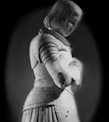 
Joan of Arc Chat

SPECIALS
Top 10 Portraits
Screensavers
Devotionals
Rare Books
eBooks
Music

Email This Page
Don't forget to bookmark us! (CTRL-D)

|
 |
 |
|
|
 |
|
|
 |
Domremy Vaucouleurs
Chinon
Orléans
Reims
Paris
Compiègne
Beaurevoir
Rouen
|
|
Map of France and England in 1429
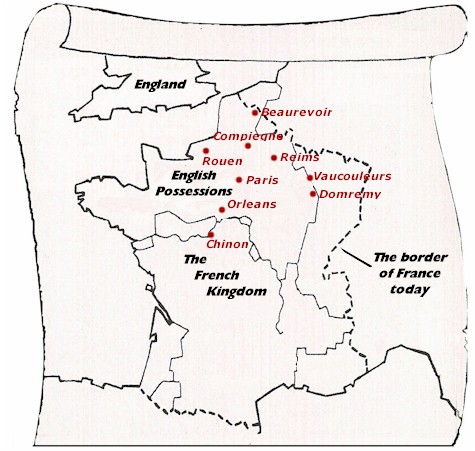
|
 |
| Back to
Map |
|
Domremy
|
|
|
It was prophesied that France would be ruined by a woman
and restored by a virgin from the borders of Lorraine...
A Simple Girl in a Divided Country
Joan of Arc was born on January 6, in the year 1412 in Domremy, a village in the East of
France. She was born amidst the Hundred Years’ War between the French and English
monarchies. During the time of Joan's birth, a tenuous truce was in effect between
France and England, however this truce was broken when civil war broke out between two
factions of the French Royal family, the Armagnacs, and the Burgundians. The English took
advantage of this opportunity allying themselves with the Burgundians in their war against
the French monarchy. With the country of France divided, King Henry V reinvaded France in
August 1415 after enforcing his family’s claim to the French throne through marriage.
This claim stripped the current heir to the French throne, Charles VII, of his crown; this
along with the alleged accusation from Charles’ own mother that he was the product of
an illicit affair. Surrounded by such deception, it is no surprise that Charles VII
gradually lost allegiance in the surrounding French territories. The exception being
territories close to Joan of Arc's home village of Domremy.
Heavenly Voices
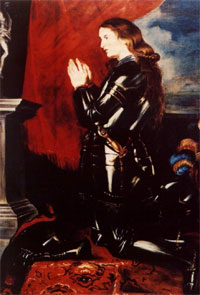 Jehanne grew up surrounded by the turmoil of a nation divided. She was noted to be an
exceptionally pious child, working the gardens and tending the livestock for her family
farm. When Jehanne was about thirteen she first heard the voice of Saint Michael and
eventually Saint Catherine and Saint Margaret. The voices deemed her Jehanne the Maid,
Child of God, instructing her to preserve her virginity and live a holy life,
dedicated to serving God. For about five years the voices provided counsel, guidance and
protection preparing young Jehanne for a greater mission—to lead in the liberation of
her country from English hands. Jehanne grew up surrounded by the turmoil of a nation divided. She was noted to be an
exceptionally pious child, working the gardens and tending the livestock for her family
farm. When Jehanne was about thirteen she first heard the voice of Saint Michael and
eventually Saint Catherine and Saint Margaret. The voices deemed her Jehanne the Maid,
Child of God, instructing her to preserve her virginity and live a holy life,
dedicated to serving God. For about five years the voices provided counsel, guidance and
protection preparing young Jehanne for a greater mission—to lead in the liberation of
her country from English hands.
The Mission Commences
In February, 1429, the voice of Saint Michael commanded Jehanne to leave Domremy to
reclaim the kingdom of France from English rule. With great faith, Jehanne departed her
village to seek assistance from her uncle Durand Lassois in the nearby village of
Burey-le-Petit. She stayed with her uncle about a week, then told him of her mission.
Witnessing Jehanne’s determination, her uncle escorted her to Vaucouleurs.
|
| Back to
Map |
|
Vaucouleurs
|
|
|
"Rather now than tomorrow, and tomorrow than the day after!"
Gaining Support
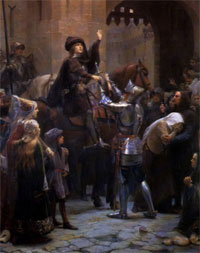 Jehanne entered Vaucouleurs with the sole purpose of seeking an appearance with the
captain of the town, Sir Robert de Baudricourt. Jehanne informed the captain that she was
traveling to Chinon to seek counsel with Charles VII. She was in need of de Baudricourt’s men and aid to accomplish this mission. Twice he refused and rejected
her, laughing her right out of his chamber. Eventually, on her third visit
around February 12, 1429, Joan predicted a French defeat near
Orléans, convincing Robert de Baudricourt to give Jehanne her own personal sword, a
knight, a squire, and four serving men for her mission. The small entourage set out from Vaucouleurs, Jehanne dressed in men’s clothing, prepared for combat. Jehanne entered Vaucouleurs with the sole purpose of seeking an appearance with the
captain of the town, Sir Robert de Baudricourt. Jehanne informed the captain that she was
traveling to Chinon to seek counsel with Charles VII. She was in need of de Baudricourt’s men and aid to accomplish this mission. Twice he refused and rejected
her, laughing her right out of his chamber. Eventually, on her third visit
around February 12, 1429, Joan predicted a French defeat near
Orléans, convincing Robert de Baudricourt to give Jehanne her own personal sword, a
knight, a squire, and four serving men for her mission. The small entourage set out from Vaucouleurs, Jehanne dressed in men’s clothing, prepared for combat.
|
| Back to
Map |
|
Chinon
|
|
|
"I bring you news from God, that our Lord will give you back your kingdom,
bringing you to be crowned at Reims, and driving out your enemies.
In this I am God's messenger."
Going to Meet the King
The small company met no resistance on their journey, arriving safely in
Sainte-Catherine-de-Fierbois. Jehanne sent a letter to King Charles VII requesting
entrance into Chinon, mentioning that they had traveled one hundred and fifty leagues to
provide information that would benefit him.
The True King is Revealed
Jehanne arrived in an inn at Chinon around noon on or around March 4. She requested an
audience with the King but was made to wait while Charles’ counselors debated if an
audience should be arranged. The King assigned the clerics and men of the church to
examine Jehanne’s authenticity before he would grant council. The decision was made
to receive Jehanne on or about March 9, 1429. All gathered at the King’s castle were
exceptionally curious about this child who professed to be sent by God. Charles was still
not convinced of Jehanne’s intention, thus he decided to trick her by switching his
clothing, blending with those gathered. When Jehanne entered the King’s chamber she
identified him immediately, giving credit to her voices. She reverently bowed before him,
proclaiming that he would hold the Kingdom of France. Jehanne imparted her mission to
raise the siege of Orléans and to
lead the Dauphin (heir to the throne) to be properly crowned and anointed as King of
France. Then, she gave the King a sign, sent from God, which only the King himself could
recognize. This apparently got Charles’ attention for he consulted with her for
hours.
Approval
After meeting with Charles VII, at his request, a three-week examination of Jehanne’s
character was held by theologians in Chinon and Poitiers. The scholars found her to be
free from flaws and authentic in her mission. The Dauphin gave Joan 10,000-12,000 men and
his blessing to proceed to
Orléans.
Jehanne prophesied to Charles, "I shall last a year, and but little longer: we must
think to do good work in that year." (In Her Own Words, p. 27).
Joan's Sword
During this time, Jehanne’s voices directed her to search for a sword in the church of Saint Catherine at Fierbois, behind the
altar. It was found rusted, with 5 crosses on it. Jehanne cherished this sword as it was found in the church of her
beloved Saint Catherine.
Joan's Battle Standard
On April 28-29 while traveling to
Orléans,
Jehanne and her army stopped at Blois where they waited for provisions to be prepared for
transport into the besieged city of
Orléans.
While in Blois, Jehanne had a banner
made to carry into battle. The field was white, sewn with lilies, with the Lord holding
the world, and two angels on either side. On the banner were written the words Jhesus Maria, and it
was fringed with silk. The artist was a Scotsman by the name of Hauves Poulnoir (Hamish
Power).
Command of an Army
Jehanne was given "titular command" meaning that she was a figurehead assigned
to preside over veteran commanders who in turn provided direct leadership. During Medieval
times, this title was occasionally given to religious visionaries. Jehanne showed great
proficiency in battle strategy and command even though she was only 17 years of age with
no prior experience. She attributed her knowledge to the counsel of her voices. Her
strategies provided decisive turning points resulting in victory against the English. Her
reputation as a saint returned to earth, proceeded her and French soldiers whom had
previously refused to fight for Charles VII, joined her ranks.
|
View Gallery
Back to Map |
|
Orléans
|
|
|
"…depart into your own country, or I will raise such
a war-cry against you as shall be remembered forever."
The Arrival
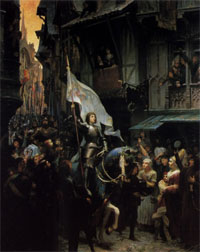 On April 29, 1429, under the cover of darkness, Jehanne entered
Orléans upon horseback, carrying her standard into the affectionate
crowds who awaited the Maid sent to rescue them. The English had cut off the city of
Orléans on three sides. In order to
break the siege, the English strongholds would need to be dismantled one by one. Jehanne
sent repeated messages to the English commanders ordering them to leave their fortresses,
but their only reply was cutting insults. The Battle of
Orléans was critical, for if the English conquered the
city, they would gain control over the entire northern perimeter of Charles’
dwindling domain. On April 29, 1429, under the cover of darkness, Jehanne entered
Orléans upon horseback, carrying her standard into the affectionate
crowds who awaited the Maid sent to rescue them. The English had cut off the city of
Orléans on three sides. In order to
break the siege, the English strongholds would need to be dismantled one by one. Jehanne
sent repeated messages to the English commanders ordering them to leave their fortresses,
but their only reply was cutting insults. The Battle of
Orléans was critical, for if the English conquered the
city, they would gain control over the entire northern perimeter of Charles’
dwindling domain.
Her First Battle
On May 4, Jehanne woke suddenly, announcing that her voices had advised to begin battle
with the English. Unknown to her, combat had already begun near the fortress of St. Loup
while she was asleep. The commanders had not kept the Maid informed. After receiving her banner she charged towards the
gate struck with grief at the unfolding bloody scene before her as countrymen were carried
into town, dead or bleeding. When she arrived at the fortress of St. Loup, the French
forces appeared to be losing the battle; when the troops saw Jehanne riding into battle,
however, her standard flying,
the French troops rallied. Three hours later, the fortress of St. Loup was taken.
It’s reported that she had great compassion for her enemy, grieving for the loss of
their life, and not allowing harm to come to the living. On the following day, battle was
halted, as it was a Holy Day, the Feast of the Ascension. She sent a final warning to the
English. Jehanne was met once more with insults. A counsel was held and a plan for the
next day’s assault was formulated.
Lifting the Siege
On May 6, 1429, the following morning, fighting resumed, focusing on two strongholds: the
fortified church of St. Jean-le-Blanc and the monastery of the Augustines. The English
abandoned St. Jean-le-Blanc attempting to consolidate forces at the fortress of the
Augustines. The French soldiers balked at the combined might of the English, but were
again rejuvenated when Jehanne rode into the head of the troops, rallying them for a final
assault. The fortress of Augustines was stormed successfully. When the troops retired
Jehanne spoke to her chaplain, informing him to rise early for "blood will flow from
my body, above my breast." (In her Own Words, p. 36).
Fighting Wounded
The next day, May 7, 1429, Les Tourelles, the most crucial fortress in English hands, was
attacked from early morning until well into the night. In the chaos of battle, the French
courageously scaled the walls, storming the fortress. Jehanne was the first to set a
ladder against the fortress, and in the process was seriously wounded in the
shoulder by a
crossbow bolt. As Jehanne was taken to safety for treatment, the French troops became
demoralized. The commanders decided to call off the assault. At hearing this, Jehanne
approached a commander and ask that he wait while she mounted her horse and withdrew into
a vineyard for prayer. Upon rising from prayer, she took up her banner and rode back into battle. At her injured
presence, the weary French soldiers were moved to valor as they ascended the walls once
again, this time meeting no resistance. On the eve of May 7, 1429 the King’s armies
captured the fortress of Les Tourelles, defeating the last major stronghold.
Victory
On May 8, 1429 the English retreated out of
Orléans. A jubilant procession followed La Pucelle (maiden
or virgin), rejoicing in their liberation from English hands. A procession is still held
annually on the anniversary of the event celebrating this day of deliverance and honoring
the Maid of Orléans.
|
View Gallery
Back to Map |
|
Reims
|
|
|
"Go forward bravely. Fear nothing.
If you will go forward like a man, you shall have your whole Kingdom!"
The Bloodless March
After securing Orléans, on May 11,
1429, Jehanne immediately met with Charles who, as reports indicate, was overwhelmed with
joy at the news. Jehanne convinced Charles to take an army north to Reims to be properly crowned, as custom required. To
successfully arrive at Reims
Cathedral, the traditional place of coronation, Joan had to accomplish
one of her greatest feats, the "Bloodless March": the most extraordinary
military campaign in history. They marched from Gien to
Reims through English occupied territory, capturing every English town
and fortress that barred the road, from the beginning of the journey to the
end of it; and this by the mere force of her name, and without shedding a
drop of blood.
Crowning the King
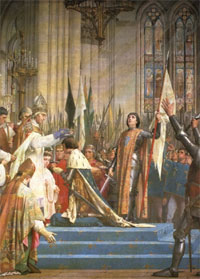 One
of the main prophetic responsibilities afforded
to Joan of Arc was to have Charles VII crowned the rightful king of France.
The victory at Orléans
paved the way to this improbable feat. The King's coronation was held in Reims
Cathedral on July 17, 1429 and was
a masterpiece of diplomacy, an advantage of incalculable importance.
Customary anointment with the holy oil linked Charles VII to the kings of
Israel and to David, and consecrated him as the King of the Francs, thereby
preempting the ad hoc coronation of Henry VI at Nôtre Dame Cathedral in Paris on December 16, 1430. Jehanne stood alongside Charles VII with her banner in hand, weeping tears of
joy. A 15-day truce was soon declared with the understanding that Paris
would be surrendered peaceably at the end of the 15 days. The English did
not honor this truce and, in fact, it only served to allow the English and
Burgundians time to regroup. Jehanne was reported as saying that she now
hoped God would soon permit her to return home to
her family. One
of the main prophetic responsibilities afforded
to Joan of Arc was to have Charles VII crowned the rightful king of France.
The victory at Orléans
paved the way to this improbable feat. The King's coronation was held in Reims
Cathedral on July 17, 1429 and was
a masterpiece of diplomacy, an advantage of incalculable importance.
Customary anointment with the holy oil linked Charles VII to the kings of
Israel and to David, and consecrated him as the King of the Francs, thereby
preempting the ad hoc coronation of Henry VI at Nôtre Dame Cathedral in Paris on December 16, 1430. Jehanne stood alongside Charles VII with her banner in hand, weeping tears of
joy. A 15-day truce was soon declared with the understanding that Paris
would be surrendered peaceably at the end of the 15 days. The English did
not honor this truce and, in fact, it only served to allow the English and
Burgundians time to regroup. Jehanne was reported as saying that she now
hoped God would soon permit her to return home to
her family.
|
View Gallery
Back to Map |
|
Paris
|
|
|
"I fear nothing but treachery…."
Shot Again
King Charles remained in Compiègne as Jehanne and the troops set out for St. Denis, a
region around Paris, sending
skirmishes up to the gates of Paris.
On September 8, 1429 a siege began but was cut short when Jehanne was wounded in the thigh
by a crossbow bolt while trying to cross the city’s inner moat. She urged to continue
the assault as she was lead to safety against her will. However, on September 9, the army
was ordered back to St. Denis, where the King now awaited their return. As was customary
among soldiers wounded in battle, Jehanne made an offering of a suit of white armor and a
sword in the name of Saint Denis, as his name is the war-cry of France. It’s reported
that in five days she was well again. Jehanne wished to proceed with the attack on Paris. However, on September 21, 1429 the
French army was ordered to disband, despite passionate protests from the Maid.
|
| Back to
Map |
|
Compiègne
|
|
|
"In the name of God! let us go on bravely!"
Defeat and Recognition
During this period of inactivity, Joan moved about various residences of the Royal court.
There were surrounding battles resulting in limited armed support and dwindling supplies.
Since the Royal court no longer supported the army, Jehanne sent letters to nearby cities
requesting donations of food supplies and money to maintain her army. The army was forced
to withdraw when the desperately needed supplies never materialized and cold weather
settled around them. Jehanne spent the rest of the winter at various Royal estates as the
English and Burgundians regrouped for the next attack. On December 29, 1429, in praise of her great deeds,
King Charles VII officially remitted the taxes on the people of Domremy and enobled the
d'Arc lineage by granting them the surname "du Lys".
Miracle
During the Easter week of April 16, Jehanne’s voices told her she would be taken
prisoner before Saint John’s Day, June 24, and that she must not be frightened but
accept it willingly, as God would help her. She begged her voices that she would not
suffer in prison but die straightway. Shortly after this time, Jehanne is said to have
performed a miracle; she brought a baby back to life long enough that it could be baptized and buried in consecrated ground.
This report of performing a miracle aided in her eventual canonization, as this is one of the criteria considered for sainthood.
Captured
Finally on May 6, 1430, King Charles admitted that the enemy had deceived the Royal Court,
as their armies were advancing despite promises of peace. Charles at last ordered
continuing assaults on the English and Burgundians. On the morning of May 23, 1430 it is
said that Jehanne arrived at Compiègne to pray at one of the churches. Her spirit was
troubled as she reportedly told a group of curious children watching, "pray for me,
for I have been betrayed." That evening she went with a company of soldiers outside
the city against the English. After crossing a bridge on an assault of Monseigneur de
Luxembourg's men, the English intercepted her and her men, cutting off their retreat.
Refusing the demands to surrender, Jehanne was pulled off her horse by a Burgundian archer
and taken prisoner amidst the thralls of battle.
|
| Back to
Map |
|
Beaurevoir
|
|
|
Ransom
Hearing that Jehanne had been taken captive, King Charles attempted to persuade the
Burgundians to release the Maid with a ransom typical of the day. The Burgundians refused
the offered ransom. In addition, attempts to rescue her were unsuccessful.
Prisoner
Jehanne was held prisoner in the château of Beaurevoir from July until November. During
her captivity, she attempted to escape by jumping from the tower. Unfortunately, she was
injured and her escape was unsuccessful. Jehanne states that the reason for this bold act
was that she had heard that all the people in Compiègne, including children, were to be
put to fire and sword. "And I would rather be dead than live on after such a
destruction of good people" (In Her Own Words, p. 87). She also stated that she
understood she had been sold to the English.
Sold to the English
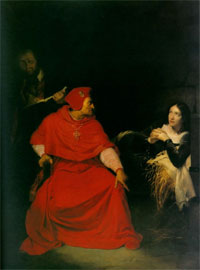 After four months imprisonment at Beaurevoir, the Maid was transferred and sold to the
English for 10,000 livres. Pierre Cauchon was given the job of acquiring her and
organizing the trial.
Cauchon had a documented reputation of bribing church officials in order to influence
court rulings. Jehanne was held at a fortress in Crotoy, then brought to Rouen, the town that housed the English
occupation government. Inquisitorial procedures required that prisoners be held in
church-run prisons and female prisoners guarded by nuns. However, Jehanne was held in a
military prison guarded by English soldiers. This was a point of great distress to her
character and explains her insistence at wearing male dress, bound and laced, to protect
her holy virginity. After four months imprisonment at Beaurevoir, the Maid was transferred and sold to the
English for 10,000 livres. Pierre Cauchon was given the job of acquiring her and
organizing the trial.
Cauchon had a documented reputation of bribing church officials in order to influence
court rulings. Jehanne was held at a fortress in Crotoy, then brought to Rouen, the town that housed the English
occupation government. Inquisitorial procedures required that prisoners be held in
church-run prisons and female prisoners guarded by nuns. However, Jehanne was held in a
military prison guarded by English soldiers. This was a point of great distress to her
character and explains her insistence at wearing male dress, bound and laced, to protect
her holy virginity.
|
View Gallery
Back to Map |
|
Rouen
|
|
|
"Jhesus,
Jhesus!"
The Trial of Condemnation
Jehanne’s trial
encompassed a series of hearings stretching from February 21 until the end of March 1431.
A series of manipulation attempts eventually led to torture when the English could not
extract the necessary charge from their prisoner. Later transcripts and witnesses of
judges that actually served on her trial admitted to such tactics.
Early in the trial,
Jehanne’s accusers charged her with "cross-dressing" and tried to link her
to witchcraft based on the powers endowed on her banner.
I Said for Fear of the Fire
Jehanne’s first sentence was read on May 24, 1431. She was taken to the Cemetery of
Saint-Ouen where she was publicly admonished. Her saints were slandered as demons, even
though their instruction only supported the church tenets, encouraging her to go to church
regularly and maintain virginity. Jehanne was presented with a written form of abjuration,
demanding that she recant her voices or be executed on the spot. The execution pyre was
readied in her presence. If she signed the written form, her accusers promised that she
would be released from English prison and held instead in the Church’s prison, free
from the hands of her enemies. She is later recorded as signing the abjuration stating
that she would rather sign it than burn. She then requested that she go immediately to the
Church prison, rather than back into English hands. Despite the promise, she was returned
to her cell in Rouen. According to
reports after this time, her guards eventually took away her dress entirely and left her
with only men’s clothes to cover herself.
Sentenced to Death
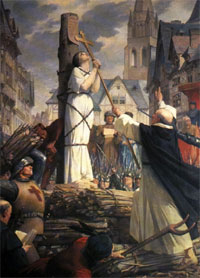 On May 28, 1431, Jehanne revoked her written Abjuration, stating "What I said, I said
for fear of the fire." (In Her Own Words, p. 136) She professed her voices true and
coming from God. Consequently, Cauchon branded her a "relapsed heretic" and
sentenced her to death. On May 28, 1431, Jehanne revoked her written Abjuration, stating "What I said, I said
for fear of the fire." (In Her Own Words, p. 136) She professed her voices true and
coming from God. Consequently, Cauchon branded her a "relapsed heretic" and
sentenced her to death.
May 30, 1431, 8 a.m., Jehanne d’Arc goes forth wearing a miter-shaped
hat with her judgment inscribed: Heretic, Relapsed, Apostate, Idolater. A number of
individuals who were present at her execution provided vivid descriptions of the day. She
is said to have listened calmly to the sermon only to break down weeping during her own
address, when she passionately forgave her accusers, asking the priests to say a mass in
her memory. At this point, the atmosphere changed and most of her judges and accusers, as
well as the English soldiers, wept at the impact of her words. The order went out to the
executioner to "do your duty." She had previously asked for a consecrated cross
to be brought before her eyes so she could gaze upon it during her last breaths. A
sympathetic English soldier is reported to have made a makeshift one out of wood until
Friar Martin Ladvenu brought a crucifix from a nearby church. As the flames consumed the
pyre, the beloved cross was held up before her eyes. Eyewitnesses recall that she yelled
repeatedly the name of Jesus, invoking the aid of the saints until her last breath ceased.
A number of English dignitaries were said to have wept bitter tears. The
Secretary to the King of England was said to have exclaimed, "We are all ruined, for
a good and holy person was burned." The executioner himself in great distress came to
the Friar who retrieved the cross, concerned that he had burned a saint. Her ashes were
thrown into the river Seine and the English authorities went about stopping any further
talk by punishing the few that publicly spoke out in Jehanne’s defense.
Joan the Saint
Finally in November 1449, near the end of the war, when the English were driven out of
France, the tedious process of appealing her case began. A posthumous acquittal transpired
proclaiming Jehanne a martyr, and denouncing Cauchon and the judges, paving the way to her
eventual beatification in 1909 and canonization as a saint in 1920.
|
|

Website design by Sojourn Photography
|
|



 Jehanne grew up surrounded by the turmoil of a nation divided. She was noted to be an
exceptionally pious child, working the gardens and tending the livestock for her family
farm. When Jehanne was about thirteen she first heard the voice of
Jehanne grew up surrounded by the turmoil of a nation divided. She was noted to be an
exceptionally pious child, working the gardens and tending the livestock for her family
farm. When Jehanne was about thirteen she first heard the voice of  Jehanne entered Vaucouleurs with the sole purpose of seeking an appearance with the
captain of the town, Sir Robert de Baudricourt. Jehanne informed the captain that she was
traveling to Chinon to seek counsel with Charles VII. She was in need of de Baudricourt’s men and aid to accomplish this mission. Twice he refused and rejected
her, laughing her right out of his chamber. Eventually, on her third visit
around February 12, 1429, Joan
Jehanne entered Vaucouleurs with the sole purpose of seeking an appearance with the
captain of the town, Sir Robert de Baudricourt. Jehanne informed the captain that she was
traveling to Chinon to seek counsel with Charles VII. She was in need of de Baudricourt’s men and aid to accomplish this mission. Twice he refused and rejected
her, laughing her right out of his chamber. Eventually, on her third visit
around February 12, 1429, Joan  On April 29, 1429, under the cover of darkness, Jehanne entered
On April 29, 1429, under the cover of darkness, Jehanne entered  One
of the main
One
of the main  After four months imprisonment at Beaurevoir, the Maid was transferred and sold to the
English for 10,000 livres. Pierre Cauchon was given the job of acquiring her and
organizing the
After four months imprisonment at Beaurevoir, the Maid was transferred and sold to the
English for 10,000 livres. Pierre Cauchon was given the job of acquiring her and
organizing the  On May 28, 1431, Jehanne revoked her written Abjuration, stating "What I said, I said
for fear of the fire." (In Her Own Words, p. 136) She professed
On May 28, 1431, Jehanne revoked her written Abjuration, stating "What I said, I said
for fear of the fire." (In Her Own Words, p. 136) She professed